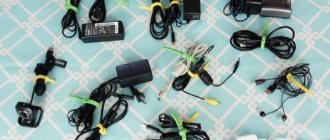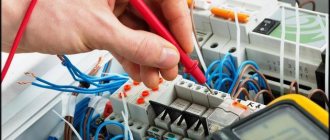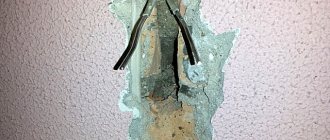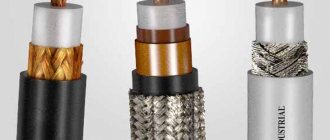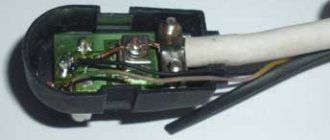Photo: planete-deco.fr Installing a television panel on the wall is one of the most rational solutions that allows you to achieve maximum freedom of space. At the same time, the question arises - how to hide wires that significantly spoil the external aesthetics of the interior? To help you in this matter, we have collected 12 great ideas, among which you will definitely find what you need!
Hiding wires in the wall
At the renovation stage, you can hide the wires from the TV in the wall. To do this, you need to accurately determine the permanent place of “residence” for the television panel.
Next, starting from the intended location of the wire, make a channel in the wall towards the electrical point and lay the cable. Use special construction staples to securely fix it, and then carefully cover it with plaster. Now you can start finishing work.
This method has one significant drawback - the television panel loses its mobility. If you need to move it to another location or send it in for repairs, removing the wire will be very problematic.
The nuances of vertical TV fixation
By fixing the TV to the wall, you not only get a stylish and original interior design, but also solve a number of practical nuances:
- First of all, there is a significant saving of free space - you can refuse additional, bulky furniture, which is especially important for small rooms.
- In the kitchen, a hanging TV can be placed in a free corner so that it does not interfere with the main process - cooking.
- In a family with small children, a TV on the wall is a necessary safety measure.
- The wires are reliably protected from mechanical damage.
- The child will not knock over a heavy object and damage the expensive device.
- By eliminating additional furniture, cleaning the room is simplified.
- If you hide the wires going to the power supply from a TV mounted on the wall, the room will look neat and aesthetically pleasing.
Not every TV can be mounted on the wall - its weight and the material from which the wall is made matter. The structure should be quite durable. It’s good if the wall is made of concrete or brick – additional measures to strengthen it will not be required, as is the case with a plasterboard wall.
When mounting the TV to the wall, a ventilation gap is left between the back wall of the device and the vertical plane, which will ensure air circulation and cooling of the equipment. When fixing the TV inside a niche, the ventilation gap must be at least 10 cm, otherwise the device will overheat.
When choosing a location for the TV, you must strive to ensure that the image on the screen is visible from anywhere in the room, but there is no glare when exposed to sunlight.
Note! When fixing the TV on the wall, you need to think about not only a way to disguise the power cable and antenna, but also wires from other equipment - a video player, home theater, digital or satellite television set-top box.
Masking with a cable channel
Use a camouflage box. With its help you will hide television wires without disturbing the surface of the wall. This structure is fastened with hidden screws and liquid nails.
Today you can purchase a cable channel model that best suits the style of the room. The simplest type is an ordinary plastic box, which after installation can be covered with the same finishing material as the entire wall.
There are models lined with decorative bricks or in the form of pipes, which are ideal for interiors in loft and hi-tech styles. For classic or eco-trends, you can choose wooden or MDF models.
Cable mounting options
Fastenings for cables and wires can be made in several options:
- Cable tie with a hole for a dowel.
- Mounting area in the form of a square.
- Clips for corrugated pipes.
- Metal bracket.
- Platform with self-adhesive backing.
Cable tie with dowel hole
A cable tie with a dowel hole is an improved design of a standard product. It is used for fastening a single cable or a bundle of conductors. This fastening for various wires allows you to do without additional intermediate parts. The loop is tightened around the cable. The self-tapping screw is driven through the hole in the clamp into a standard dowel.
Screed with a hole for a dowel
The fasteners are made of nylon. The locking opening allows the toothed belt to move in one direction only. The screed is dismantled using sharp tape.
Mounting area in the form of a square
The support platforms are made of nylon. Products come in three types:
- with a hole for a dowel or screw;
- platform with dowel;
- Adhesive fastening.
All types of products have grooves for threading tie tape. The polymer platforms are square in shape. Their sizes are 19x19, 28x28, 40x40 mm.
Clips for corrugated pipe
To isolate the surface of the cables from external negative factors, they are pulled into corrugated pipes. To attach the corrugations to the walls and ceiling, use clips for wires.
Clip design
Fasteners are necessary for fixing corrugated pipes on vertical fences indoors. Clips for fastening cables have latching brackets. They unbend under force, letting the pipe inside, and immediately snap into place. The base of the products has holes for dowels or screws.
Clips for fastening cables in corrugated pipes have the following working diameters: 16, 20, 25, 32, 40 and 50 mm.
Metal bracket
Metal staples are used as reliable fastening of wires on walls. The fasteners have technological holes through which the brackets are attached using screws, self-tapping screws or fired with a dowel gun.
Metal products can have one or two legs. Two-component holders consist of two brackets connected through ebbs with screws. The lower stock has a hole for a dowel screw. It has an international marking indicating the diameter of the coverage.
For example, GN 20 means a single-jaw staple with a reach diameter of 19-20 mm. CZ 16 – two-legged holder with a diameter of 16-17 mm. A two-component bracket with an internal diameter of 31-32 mm is designated as C 32.
Platform with self-adhesive backing
The products are plastic squares with protrusions in the form of grooves for ties. The back side is covered with double-sided tape.
Self-adhesive pads are used when it is necessary to attach wires to the wall without violating the integrity of the fence surface. Fasteners are quick installation parts.
Self-adhesive pads
Hiding behind drywall
Drywall is widely used in the design of modern interiors, as it allows you to mask surface imperfections and create original decorative designs. Why not take advantage of this?
Come up with a wall structure, for example, in the form of a plasterboard box with niches, shelves and, of course, space for a television panel. After installation, all wires will be securely hidden, and the interior of the room will become more stylish and functional.
You can build a false fireplace from drywall and install a TV above it. This way you will get a great seating area, and the wires will be securely hidden.
The nuances of vertical TV fixation
By fixing the TV to the wall, you not only get a stylish and original interior design, but also solve a number of practical nuances:
- First of all, there is a significant saving of free space - you can refuse additional, bulky furniture, which is especially important for small rooms.
- In the kitchen, a hanging TV can be placed in a free corner so that it does not interfere with the main process - cooking.
- In a family with small children, a TV on the wall is a necessary safety measure.
- The wires are reliably protected from mechanical damage.
- The child will not knock over a heavy object and damage the expensive device.
- By eliminating additional furniture, cleaning the room is simplified.
- If you hide the wires going to the power supply from a TV mounted on the wall, the room will look neat and aesthetically pleasing.
Not every TV can be mounted on the wall - its weight and the material from which the wall is made matter. The structure should be quite durable. It’s good if the wall is made of concrete or brick – additional measures to strengthen it will not be required, as is the case with a plasterboard wall.
When mounting the TV to the wall, a ventilation gap is left between the back wall of the device and the vertical plane, which will ensure air circulation and cooling of the equipment. When fixing the TV inside a niche, the ventilation gap must be at least 10 cm, otherwise the device will overheat.
When choosing a location for the TV, you must strive to ensure that the image on the screen is visible from anywhere in the room, but there is no glare when exposed to sunlight.
Note! When fixing the TV on the wall, you need to think about not only a way to disguise the power cable and antenna, but also wires from other equipment - a video player, home theater, digital or satellite television set-top box.
How to hide wires in furniture
The TV can be installed in a wall set, which will hide all communications in its depths. But if you don’t like bulky structures, use modular elements, such as a wall cabinet.
Many modern models of such furniture already have special holes in their design into which wires are laid.
Stretch ceilings in the interior of an apartment (200 photos)
Wire panel
If you are a creative person, come up with some kind of wall drawing, the contours of which you will draw with wire. You can find quite a lot of such ideas on the Internet!
Draw a sketch on the wall with a pencil and start laying. Don’t forget that the pattern or geometric figure should fit harmoniously into the interior.
An important point is the method of fixation. Nails are not suitable for this work - they can damage the cable and spoil the design with their unaesthetic appearance. Therefore, use double-sided tape or glue.
Cable laying procedure
TV cable wiring in an apartment can be done in two ways: open, and in cable channels or grooves.
Cable laying technology offers:
The section located from the panel wiring to the branch into the apartment is laid in a cable channel.
- From the branch, the wire is connected through F-connectors. In this case, it is better to use threaded options. The presence of an internal thread allows, if necessary, to easily remount the entire network.
- The splitter is installed. For him, an important condition is choosing the right place. In this case, it is necessary to ensure that the interior of the room is not spoiled due to the not very presentable appearance of the device. However, the device cannot be hidden far away so that it can be easily accessed.
Splitter installation
The socket is mounted (see How to connect a television socket). It is selected for the required F-connector, which can be straight or angular.
Antenna cable installation rules
- The television cable is placed in a channel with “low-current” lines, such as alarm lines, telephone lines, and the Internet.
- All lines and TV cable distribution throughout the apartment should be done in long, whole pieces.
- It is necessary to avoid crossing television cables and power lines of the electrical network, and if necessary, cross the wires at right angles.
- Installation work should be carried out with only factory-made TV signal dividers and splitters. In this case, reliable contact of the wires and shielding of the incoming signal is ensured. This is not ensured by any twisting of wires, which means there will be no high-quality signal for TV.
- Laying of cable lines must be done using a special television cable of the RK 75 brand or a special cable for digital television.
- Laying and connecting a TV cable cannot be carried out by forming a cable loop, twisting it into a coil, or with sharp bends. This will immediately lead to a deterioration in the quality of signal reproduction.
- When laying a TV cable and power line together, you need to use a TV cable with a central wire diameter of at least 1 mm, and preferably with double shielding: two layers of foil located above and below the braid.
https://youtube.com/watch?v=QM0h6JNZ9Jg
Cable wiring in the apartment
Instructions for installing a cable into an apartment suggest:
On the top floor of the building there is a switchboard from which many different wires run. They are marked according to their belonging to a specific apartment.
Switchboard
- The required cable is determined and stretched to the required floor.
- A small hole is drilled near the door so that the wire can be pulled through it into the apartment.
- Indoors, the cable is secured near the front door with special wall mounts.
Cable installation in an apartment
The wiring runs from the door to the TV. Usually, for this purpose, the cable is hidden with special structures.
A complete overview of the cable laying work helps to get a video where all the steps are discussed and useful tips are given.
How to disguise a TV cable
After the television cable wiring in the apartment is completed, there is a need to hide it. This can be done in several ways.
For example:
Hide the wires in a plastic box, which is a fairly long structure - about two meters, the upper part of which opens. You can fix the box on the wall with glue or self-tapping screws, as in the photo.
Plastic box for cable laying
Lay the wiring behind the baseboard. In this case, the bar is removed, and after placing the cable, it is again attached to its original place. You can use floor skirting boards that have cable channels.
Cable laying in baseboards
When renovating an apartment, you can hide the wiring by making small recesses in the wall for the cable, and then plastering the walls. This is the safest option.
Preparing the wall for laying cables
Properly selected wires for wiring in the apartment, the use of high-quality devices and accessories, and professional installation of the system will allow you to receive a reliable TV signal from cable television.
Masking with vinyl stickers
Interior vinyl stickers are an excellent decorative material. Its main advantage is that it allows you to quickly transform the interior and emphasize style. At the same time, such decor can be removed or replaced with a new one at any time without any problems.
Use vinyl stickers to create decorations where the TV cable is located. It could be a branchy tree, with the crown of which the cable will blend into the color palette.
Selecting a TV cable
Wiring an antenna cable in an apartment begins with the selection of high-quality materials and equipment.
The main characteristics of the cable are:
- Length.
- Thickness.
- Bandwidth.
To transmit high quality television signals, it is recommended to use the following types of television cables:
- Brands RK 75-4-11 and RK 50-7-11 are excellent for cable television.
- Brands R0K 75-4.8-318 and RK 75-4.8-312 are good to use for digital television.
- Brand RK 75-2-13 , this is a more flexible wire with a smaller diameter, used for small cables running from the TV socket to the TV. The price of such a wire is the lowest.
Cable brand RK 75-2-13
Wires behind a wooden panel
Installing a wooden panel with a TV will not only adequately highlight the design of the room, but will also become an excellent camouflage element that will allow you to hide the wires.
Wooden panels can have a different color palette and shape, adding sophistication and presentability to the interior. In addition, the material will serve as a good sound insulator, so you won’t have to worry about the indignation of picky neighbors who are dissatisfied with the increased volume.
60+ beautiful narrow bedroom design ideas (photos)
Branches of dry and artificial plants
Wires from the TV can also be hidden using branches of artificial plants. Place a vase with dry twigs near or under the TV panel and all attention will shift to an attractive-looking composition.
You can use special wire covers in the form of branches, which are quite similar in design to cable channels, but at an aesthetic level they are much superior. Such functional decor will look great in a children's room.
The TV seems to be hanging crookedly
All work is completed: holes are drilled, bolts are tightened, cables are pulled, the TV is hung. And now you are looking at a brand new TV panel on the wall, but something is wrong... The TV is hanging crookedly! So what should I do? Drill again? Scream or cry? Nothing out of this. There is almost always a way to level the TV on the bracket. Keep in mind that the TV is not always to blame: crooked ceilings, floors and walls create the effect of a crookedly hung TV.
A small building level is always useful on the farm
Level the TV with your hands. Seriously. This often helps. You just need to grab the panel on the sides and tilt it slightly in the desired direction. It all depends on how tightly the bolts are tightened. If they are overtightened, then there is little chance. Be that as it may, you need to act carefully - you should not hang onto the TV with full force (you may fall).
Loosen, move, tighten. Remove the TV, loosen the bolts on the mating part that is attached to the TV itself, and move it up and down. After tightening the bolts back, hang the TV and see what happens. If this does not help, you will have to remove the TV panel again and do the same with the base on the wall.
Improvisation. If all else fails, it’s time to get smart. For example, you can drill out the bracket holes a little so that there is some play for tilting to one side. Just don't worry about making huge holes and ruining the bracket. If by chance the hole turns out to be too large, you can buy a washer and place it under it.
Wires in “ethnic” style
If the interior of your TV room is decorated in an ethical style or you simply like to surprise with the “quirks” of the interior, take note of the option of masking wires with beads. Of course, you will need fairly large parts that will fit freely on the cable.
Pay attention to the selection of colors - you can choose plain details to match the color of the wall or contrasting ones that attract attention. White and red beads are suitable for wallpaper in warm colors, and blue, green and black - in cold colors.
What and how to buy for electrical wiring installation
Now that you know exactly what electrical devices and accessories you will need, how many corners and turns you plan, how many meters of electrical wires and cable channels will be required for installation, you can go to the store. When buying, take extra of everything.
- Take 4-5 meters more cable boxes and electrical wires;
- Accessories - 2-3 pieces each;
- Sockets and switches - 1-2.
Surely, when creating the project, you missed something or miscalculated. It is possible that errors may occur during operation, which will lead to damage to the device. Having extra parts will save you from unnecessary trips to the store. In the store, check each part for integrity, so that all elements are free of cracks and dents, and the lids on the boxes should hold
It is important. If you feel that the cover does not snap well or does not adhere well to the profile, request replacement. Important: when choosing electrical devices and wires, do not save
Choose only certified quality products. The fire safety of the apartment and the safety of family members depend on this. Experienced electricians prefer copper wires. Important: It is prohibited to connect aluminum and copper wires together in one twist. Firstly, such a connection is fraught with electrolysis, and secondly, the wires have different linear expansion when heated, which is possible when a current of more than 800 volts passes. As a result, the contacts will weaken, which leads to even greater heating. And this is fraught with burnout of insulation, short circuit and fire. When calculating sockets, take into account the number of constantly operating electrical household appliances. For devices that consume electricity more than 1000 W, it is recommended to install a separate outlet with a separate wire. For low-current electrical appliances, you can choose a unit connected by one pair of wires and consisting of 3-5 sockets. Along with the fittings, you also need to buy fastening elements:
- Liquid nails, screws with or without plastic dowels;
- Wire connectors – terminal blocks, caps, sleeves;
- Insulating tape.
Installation of cable boxes begins from the distribution board (box), which is usually located at the entrance to the house. The counter is also installed here. From here the wires branch out and run throughout the house. Therefore, it is advisable to connect larger boxes to the distribution board than those that will be installed in the rooms. And a residual current device (RCD) must be installed in the switchboard.
Hiding wires with threads and ropes
Another simple way to hide TV wires is to wrap them with colored threads, ribbons or jute rope.
You can choose one of several design methods. For example, simply twist the wire or braid it with a pigtail. The color of the material should be in harmony with the surrounding environment.
Suspended ceilings: 100 design ideas (photos)
Use books and magazines
Even books can be good helpers in trying to hide television wires. Try to choose ones that have a neat, aesthetic appearance or with bright covers.
Books and magazines can be stacked on a table or shelf under the TV. Pick up a couple of high-end editions that will reach all the way to the television panel. Don't overdo it with the quantity - keep it small so as not to create a mess.
Open type electrical wiring in hard-to-reach and difficult places
Doors and interior partitions are considered hard-to-reach or difficult places to install open wiring. In such a partition for installing a cable channel, it is necessary to create a special hole for inserting a plastic tube of the required diameter. Then the electrical cables are placed directly in this plastic tube. If the electrical cable is laid at the bottom of the room along a wall that has a doorway, then it is necessary to run the electrical cables around or over the doorway. In accordance with the electrical installation rules, it is not allowed to lay an electrical cable under laminate or linoleum in such an area. Where the door opening is installed, local built-in electrical wiring must be used, i.e. make a special groove in the floor screed, lay protection for the electrical cable in this place, and lay the electrical cable directly through the installed protection.
Phytostena
Installing a phytowall is a stylish solution for any modern interior. It is a large panel with “pockets” in which plants are placed. Installing a TV in such a frame has many advantages, one of which is the ability to hide the wires.
In addition to the fact that the design of the room will not be disturbed by the carelessness of a hanging cable, you will be able to enjoy watching your favorite TV shows surrounded by clean, humidified air, which is important for a city dweller!
